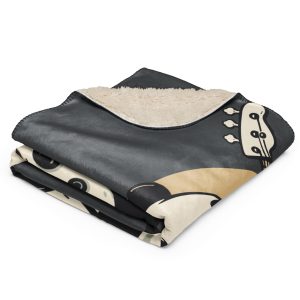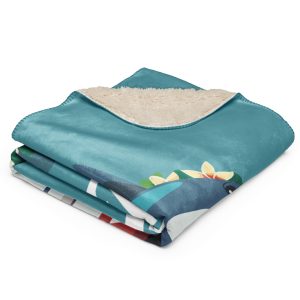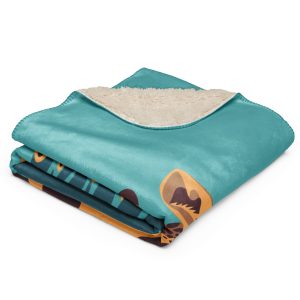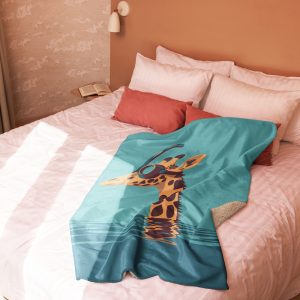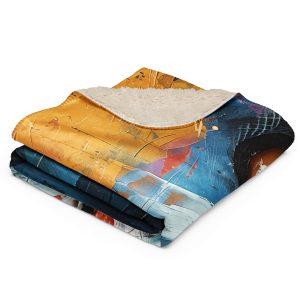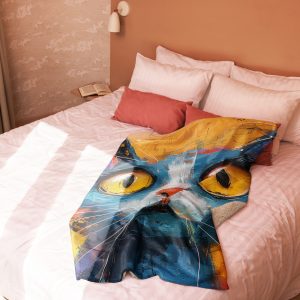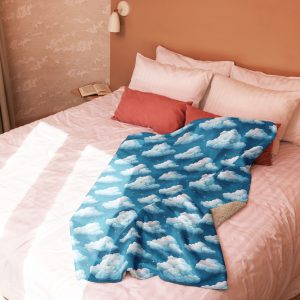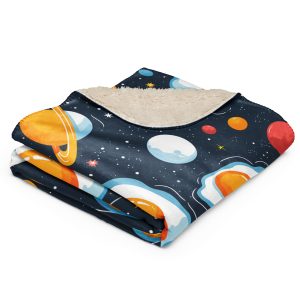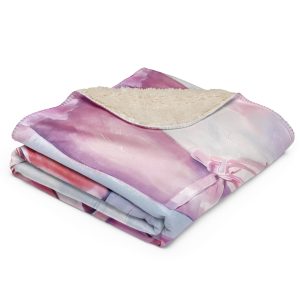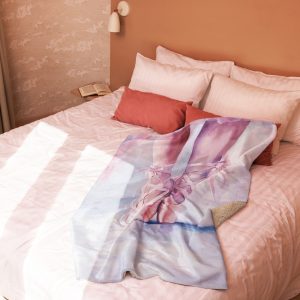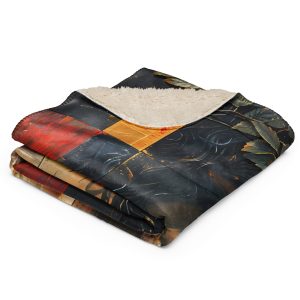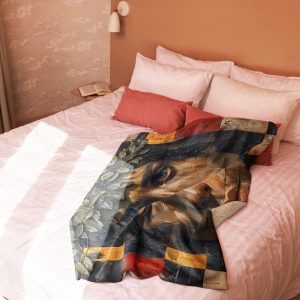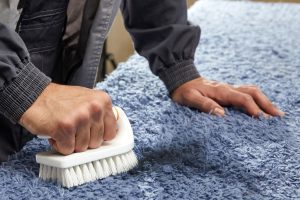Sherpa blankets, with their irresistibly soft and plush texture, have become a staple for cozy comfort in countless homes. However, for those who suffer from allergies, the question of whether these beloved blankets are a snuggly solution or a potential trigger for sneezes and sniffles is a valid concern. In this comprehensive guide, we’ll delve into the world of sherpa blankets and allergies, exploring their compatibility and offering valuable tips to ensure a comfortable and allergy-friendly experience. So, if you’re wondering, “Are sherpa blankets good for allergies?”, you’ve come to the right place.
Introduction: The Appeal (and Concerns) of Sherpa Blankets and Allergies
Sherpa blankets have undeniable appeal. Their soft, fluffy texture invites you to curl up and get cozy, making them a popular choice for snuggling on the couch, adding an extra layer of warmth to your bed, or simply enjoying a relaxing evening at home. The popularity of sherpa blankets has soared in recent years, but for individuals with allergies, the question of their suitability remains.
Allergies can be triggered by various substances, including dust mites, pet dander, pollen, and mold. These allergens can lurk in bedding, carpets, and other household items, causing a range of symptoms from sneezing and runny nose to itchy eyes and skin irritation. The plush nature of sherpa blankets raises questions about whether they might harbor these allergens, potentially exacerbating allergy symptoms.
In this article, we’ll examine the relationship between sherpa blankets and allergies, exploring the potential risks and benefits for those with sensitivities. We’ll delve into the composition of sherpa fabric, its interaction with common allergens, and offer practical tips for minimizing allergen exposure while still enjoying the cozy comfort of sherpa blankets.
Understanding Allergies: Triggers and Reactions
Before we dive into the specifics of sherpa blankets and allergies, it’s important to understand the basics of allergies and how they manifest. Allergies occur when the immune system overreacts to a harmless substance, known as an allergen. Common allergens include dust mites, pet dander, pollen, mold spores, and certain foods.
When an individual with allergies comes into contact with a trigger, their immune system releases chemicals like histamine, which cause allergic reactions. These reactions can range from mild symptoms like sneezing, runny nose, and watery eyes to more severe symptoms like difficulty breathing, skin rashes, and even anaphylaxis in extreme cases.
Identifying and avoiding allergy triggers is crucial for managing allergies effectively. This involves taking steps like regularly cleaning your home, using air purifiers, and avoiding exposure to known allergens. When it comes to bedding, choosing the right materials and taking proper care of them can make a significant difference in reducing allergy symptoms.
The Nature of Sherpa Fabric: What’s It Made Of?
Sherpa fabric, known for its luxurious softness and warmth, is typically made from polyester, a synthetic fiber derived from petroleum. While polyester is generally considered hypoallergenic, meaning it’s less likely to trigger allergies than natural fibers like wool, it’s important to note that sherpa’s plush texture can create a haven for dust mites and other allergens.
Unlike tightly woven fabrics, sherpa’s fluffy fibers offer ample space for dust mites to burrow and thrive. Dust mites are microscopic creatures that feed on dead skin cells and thrive in warm, humid environments like bedding. Their droppings and body fragments can become airborne and trigger allergic reactions in sensitive individuals.
Sherpa Blankets and Dust Mites: A Closer Look
Dust mites are a common allergen, and their presence in bedding can significantly impact allergy sufferers. While sherpa blankets themselves do not cause allergies, their plush fibers can create an environment conducive to dust mite growth.
Several factors contribute to dust mite accumulation in sherpa blankets, including:
- Warmth: Dust mites thrive in warm temperatures, and sherpa blankets provide an ideal environment for them to multiply.
- Humidity: Dust mites also need moisture to survive, and sherpa blankets can trap moisture from sweat or humidity in the air.
- Food Source: Dust mites feed on dead skin cells, which are shed by humans and pets and can accumulate in bedding.To minimize the risk of dust mite buildup, it’s crucial to wash your sherpa blanket regularly in hot water. Hot water kills dust mites and helps remove their allergens. You can also consider using a zippered allergen-proof cover for your sherpa blanket to create an additional barrier against dust mites.Are you curious about dust mite allergies and their impact? Learn more about the causes, symptoms, and treatment options by reading the informative article on dust mite allergy on Wikipedia https://en.wikipedia.org/wiki/Dust_mite_allergy
Sherpa Blankets and Pet Dander: Friend or Foe?
If you have furry friends sharing your home, pet dander can be a major allergy trigger. Pet dander consists of tiny flakes of skin shed by animals, and it can become airborne and settle on surfaces like bedding.
Sherpa blankets, with their plush texture, can easily trap pet dander, making them a potential problem for people with pet allergies. Even if your pet doesn’t directly sleep on the blanket, their dander can still find its way onto the fabric.
To minimize pet dander on your sherpa blanket, consider the following tips:
- Regular Washing: Wash your sherpa blanket frequently, especially if your pets have access to it.
- Lint Roller: Use a lint roller to remove pet hair and dander from the blanket’s surface.
- Restrict Pet Access: If possible, try to keep your pets off the blanket to minimize dander accumulation.
Other Allergens and Sherpa Blankets
While dust mites and pet dander are the most common allergens associated with sherpa blankets, other allergens like pollen and mold can also pose a problem for sensitive individuals.
Pollen can be carried indoors on clothing or shoes and can settle on bedding, including sherpa blankets. Mold can grow in humid environments, and if your sherpa blanket becomes damp, it could become a breeding ground for mold spores.
To minimize exposure to these allergens, wash your sherpa blanket regularly and ensure it’s thoroughly dried before storing it. Avoid using it outdoors during high pollen seasons, and keep your bedroom well-ventilated to reduce humidity and prevent mold growth.
Tips for Allergy Sufferers Considering Sherpa Blankets
If you’re an allergy sufferer who loves the cozy feel of sherpa blankets, don’t despair!
You can still enjoy their comfort by following these tips:
- Choose Hypoallergenic Sherpa Blankets: Look for sherpa blankets made with tightly woven fibers that are less likely to trap allergens. Some brands offer hypoallergenic sherpa options specifically designed for allergy sufferers.
- Wash Before Using: Always wash your new sherpa blanket before using it for the first time. This will remove any manufacturing residues or chemicals that could trigger allergies.
- Regular Washing: Wash your sherpa blanket frequently, ideally once a week, in hot water to kill dust mites and remove allergens.
- Allergen-Proof Cover: Consider using a zippered allergen-proof cover for your sherpa blanket. These covers create a barrier that prevents dust mites and other allergens from penetrating the fabric.
- Keep Pets Off: If you have pet allergies, try to keep your furry friends off your sherpa blanket to minimize dander exposure.
- Maintain a Clean Environment: Vacuum and dust your bedroom regularly to reduce the overall level of allergens in your environment.
Alternatives to Sherpa Blankets for Allergy Sufferers
If you find that sherpa blankets trigger your allergies despite taking precautions, there are alternative blanket materials you can consider. Some hypoallergenic options include:
- Cotton: Cotton is a natural fiber that is generally considered hypoallergenic. It’s breathable and easy to care for, making it a good choice for allergy sufferers.
- Bamboo: Bamboo fabric is naturally hypoallergenic and antibacterial, making it an excellent option for those with sensitivities. It’s also incredibly soft and moisture-wicking.
- Tencel: Tencel is a sustainable fabric made from wood pulp that is known for its softness, breathability, and moisture-wicking properties. It’s also hypoallergenic and resistant to dust mites.
Q: Are sherpa blankets hypoallergenic?
A: Sherpa blankets themselves aren’t inherently hypoallergenic. However, some manufacturers offer sherpa blankets made with tightly woven fibers and treated with hypoallergenic materials, making them a better choice for allergy sufferers.
Q: Can sherpa blankets trigger allergies?
A: While sherpa fabric itself doesn’t typically cause allergies, its plush texture can trap allergens like dust mites and pet dander, potentially triggering symptoms in sensitive individuals.
Q: Can I still use a sherpa blanket if I have allergies?
A: Yes, you can! Choose hypoallergenic options, wash them regularly in hot water, and consider using an allergen-proof cover to minimize exposure to allergens.
Q: How often should I wash my sherpa blanket if I have allergies?
A: It’s recommended to wash your sherpa blanket weekly in hot water to kill dust mites and remove other allergens.
Q: Are there any alternatives to sherpa blankets for allergy sufferers?
A: Yes, there are! Consider blankets made from materials like cotton, bamboo, or Tencel, which are naturally hypoallergenic and less likely to trap allergens.
Q: Can I use a sherpa blanket if I have asthma?
A: If you have asthma triggered by dust mites or other allergens, it’s best to consult your doctor before using a sherpa blanket. They can advise you on the best bedding options for your specific needs.
Q: What's the best way to prevent dust mites from accumulating in my sherpa blanket?
A: Wash your sherpa blanket regularly in hot water, use an allergen-proof cover, and keep your bedroom clean and well-ventilated to reduce humidity.
Q: Can I use a lint roller on my sherpa blanket to remove pet dander?
A: Yes, a lint roller can be helpful for removing pet hair and dander from the surface of your sherpa blanket.
Q: Is it okay to dry my sherpa blanket in a dryer?
A: Yes, you can tumble dry your sherpa blanket on low heat. Avoid using dryer sheets, as they can leave residue that reduces the blanket’s absorbency.
Q: Can I take my sherpa blanket to a professional cleaner?
A: It’s usually safe to take your sherpa blanket to a professional cleaner, but be sure to inform them about any allergies you have so they can choose appropriate cleaning methods.
Conclusion
Making an Informed Decision About Sherpa Blankets and Allergies
Sherpa blankets can be a cozy and comforting addition to your home, but it’s important for allergy sufferers to take precautions to minimize allergen exposure. By choosing hypoallergenic options, washing them regularly, and using allergen-proof covers, you can enjoy the luxurious feel of sherpa without compromising your health.
If you experience allergy symptoms after using a sherpa blanket, consider switching to an alternative hypoallergenic material. Ultimately, the best blanket for you is the one that provides comfort without triggering allergies or other sensitivities.
Remember, being informed and taking proactive steps can help you create a healthy and comfortable sleep environment, allowing you to enjoy the warmth and coziness of a sherpa blanket without the sneezy side effects.
FAQs about Sherpa Blankets and Allergies
I am text block. Click edit button to change this text. Lorem ipsum dolor sit amet, consectetur adipiscing elit. Ut elit tellus, luctus nec ullamcorper mattis, pulvinar dapibus leo.



